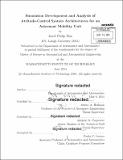| dc.contributor.advisor | Jeffrey A. Hoffman and M/lichele D. Carpenter. | en_US |
| dc.contributor.author | Rize, Jared Philip | en_US |
| dc.contributor.other | Massachusetts Institute of Technology. Department of Aeronautics and Astronautics. | en_US |
| dc.date.accessioned | 2014-10-08T15:29:20Z | |
| dc.date.available | 2014-10-08T15:29:20Z | |
| dc.date.copyright | 2014 | en_US |
| dc.date.issued | 2014 | en_US |
| dc.identifier.uri | http://hdl.handle.net/1721.1/90790 | |
| dc.description | Thesis: S.M., Massachusetts Institute of Technology, Department of Aeronautics and Astronautics, 2014. | en_US |
| dc.description | Cataloged from PDF version of thesis. | en_US |
| dc.description | Includes bibliographical references (pages 135-136). | en_US |
| dc.description.abstract | Control-moment gyroscopes (CMGs) are spacecraft attitude-control actuators which control the spacecraft's orientation and pointing. CMGs operate on electrical power and therefore obey the the conservation of angular momentum. Single-gimbal CMGs are equipped with a high-speed flywheel which can be gimbaled to impart gyroscopic torques. The net reaction torques are observed by the spacecraft resulting in pure rotation. A CMG based attitude control system (ACS) is favorable compared to a cold gas thruster ACS because of fundamental differences in how the reaction torques are produced. CMGs provide a continuous range of motion while RCS thrusters are limited by the minimum on-off time for the thruster valves. This minimum open-close time leads to a bang-bang response as opposed to the smoother CMG response. Furthermore, CMGs are powered using batteries and can therefore be recharged, while RCS thrusters use propellant which depletes over time. CMG sizing, the act of designing and choosing the electrical and mechanical parameters for a given spacecraft ACS, is studied in this thesis. The CMG sizing tool analyzes the specific system configuration (i.e. mass properties, thruster location and placement, CMG architecture, etc.) and the mission and system requirements to provide an "idealized" CMG model. Detailed simulation results and recommendations are presented for the design and analysis of the Mobility Augmenting Jetpack with Integrated CMGs (MAJIC) system. The CMG sizing software acts as a parametric tool which can be adopted to any spacecraft system. | en_US |
| dc.description.statementofresponsibility | by Jared Philip Rize. | en_US |
| dc.format.extent | 136 pages | en_US |
| dc.language.iso | eng | en_US |
| dc.publisher | Massachusetts Institute of Technology | en_US |
| dc.rights | M.I.T. theses are protected by copyright. They may be viewed from this source for any purpose, but reproduction or distribution in any format is prohibited without written permission. See provided URL for inquiries about permission. | en_US |
| dc.rights.uri | http://dspace.mit.edu/handle/1721.1/7582 | en_US |
| dc.subject | Aeronautics and Astronautics. | en_US |
| dc.title | Simulation development and analysis of attitude-control system architectures for an astronaut mobility unit | en_US |
| dc.type | Thesis | en_US |
| dc.description.degree | S.M. | en_US |
| dc.contributor.department | Massachusetts Institute of Technology. Department of Aeronautics and Astronautics | |
| dc.identifier.oclc | 891574482 | en_US |
